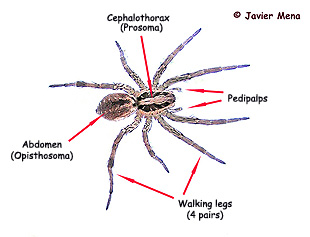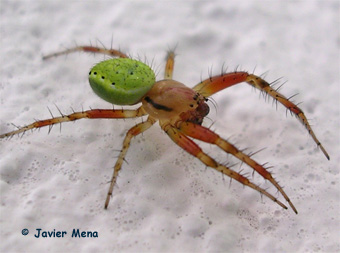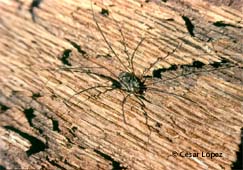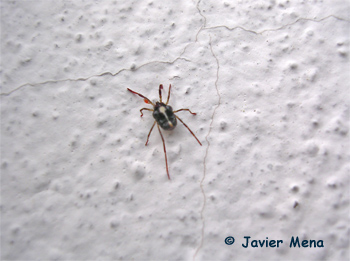 The Subphylum Chelicerata includes the arachnids, horseshoe crabs,
scorpions and related forms.
The Subphylum Chelicerata includes the arachnids, horseshoe crabs,
scorpions and related forms.
 In the Chelicerata, unlike insects, have only two body segments instead
of three: a fused head and thorax (called a cephalothorax
or prosoma) and an abdomen
(also called the opisthosoma).
In the Chelicerata, unlike insects, have only two body segments instead
of three: a fused head and thorax (called a cephalothorax
or prosoma) and an abdomen
(also called the opisthosoma).
 Chelicerata species may be easily distinguished from insects by the
fact that they have eight legs whereas
insects have six.
Chelicerata species may be easily distinguished from insects by the
fact that they have eight legs whereas
insects have six.
 As opposed to other arthropods,
the quelicerados have no antennae. They have some appendices called
pedipalps. In the spiders they have sensory
function, in the scorpions, the pedipalps have been transformed into
pincers. Moreover, they
use specialised and sensitive hairs on their legs to pick up scent,
sounds, vibrations and air currents
As opposed to other arthropods,
the quelicerados have no antennae. They have some appendices called
pedipalps. In the spiders they have sensory
function, in the scorpions, the pedipalps have been transformed into
pincers. Moreover, they
use specialised and sensitive hairs on their legs to pick up scent,
sounds, vibrations and air currents
 The
Chelicerae are pointed appendages which are used by the chelicerates
to grasp food, and are found in place of the chewing mandibles most
other arthropods have. With the chelicerae they inject the poison (spiders).
The
Chelicerae are pointed appendages which are used by the chelicerates
to grasp food, and are found in place of the chewing mandibles most
other arthropods have. With the chelicerae they inject the poison (spiders).
 They are terrestrial animals with the exception
of a living fossil: the "horseshoe crabs" that live in the
Pacific ocean and that in spite of its name, nothing has to do with
the crustaceans.
They are terrestrial animals with the exception
of a living fossil: the "horseshoe crabs" that live in the
Pacific ocean and that in spite of its name, nothing has to do with
the crustaceans.
The Subphylum Chelicerata includes the arachnids, horseshoe crabs, scorpions and related forms.
In the Chelicerata, unlike insects, have only two body segments instead of three: a fused head and thorax (called a cephalothorax or prosoma) and an abdomen (also called the opisthosoma).
Chelicerata species may be easily distinguished from insects by the fact that they have eight legs whereas insects have six.
As opposed to other arthropods, the quelicerados have no antennae. They have some appendices called pedipalps. In the spiders they have sensory function, in the scorpions, the pedipalps have been transformed into pincers. Moreover, they use specialised and sensitive hairs on their legs to pick up scent, sounds, vibrations and air currents
The Chelicerae are pointed appendages which are used by the chelicerates to grasp food, and are found in place of the chewing mandibles most other arthropods have. With the chelicerae they inject the poison (spiders).
They are terrestrial animals with the exception of a living fossil: the "horseshoe crabs" that live in the Pacific ocean and that in spite of its name, nothing has to do with the crustaceans.








